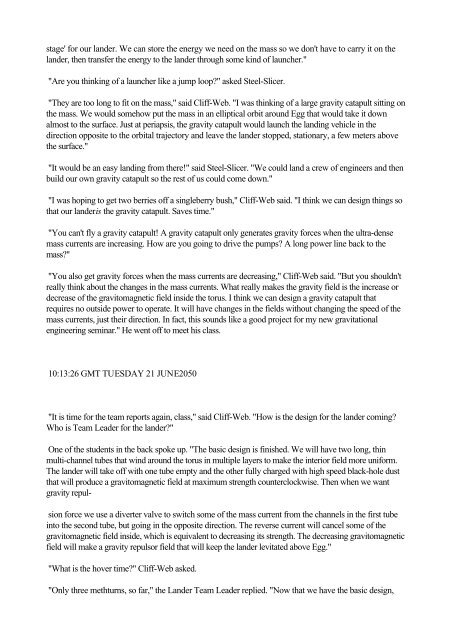You also want an ePaper? Increase the reach of your titles
YUMPU automatically turns print PDFs into web optimized ePapers that Google loves.
stage' for our lander. We can store the energy we need on the mass so we don't have to carry it on the<br />
lander, then transfer the energy to the lander through some kind of launcher."<br />
"Are you thinking of a launcher like a jump loop?" asked Steel-Slicer.<br />
"They are too long to fit on the mass," said Cliff-Web. "I was thinking of a large gravity catapult sitting on<br />
the mass. We would somehow put the mass in an elliptical orbit around Egg that would take it down<br />
almost to the surface. Just at periapsis, the gravity catapult would launch the landing vehicle in the<br />
direction opposite to the orbital trajectory and leave the lander stopped, stationary, a few meters above<br />
the surface."<br />
"It would be an easy landing from there!" said Steel-Slicer. "We could land a crew of engineers and then<br />
build our own gravity catapult so the rest of us could come down."<br />
"I was hoping to get two berries off a singleberry bush," Cliff-Web said. "I think we can design things so<br />
that our landeris the gravity catapult. Saves time."<br />
"You can't fly a gravity catapult! A gravity catapult only generates gravity forces when the ultra-dense<br />
mass currents are increasing. How are you going to drive the pumps? A long power line back to the<br />
mass?"<br />
"You also get gravity forces when the mass currents are decreasing," Cliff-Web said. "But you shouldn't<br />
really think about the changes in the mass currents. What really makes the gravity field is the increase or<br />
decrease of the gravitomagnetic field inside the torus. I think we can design a gravity catapult that<br />
requires no outside power to operate. It will have changes in the fields without changing the speed of the<br />
mass currents, just their direction. In fact, this sounds like a good project for my new gravitational<br />
engineering seminar." He went off to meet his class.<br />
10:13:26 GMT TUESDAY 21 JUNE2050<br />
"It is time for the team reports again, class," said Cliff-Web. "How is the design for the lander coming?<br />
Who is Team Leader for the lander?"<br />
One of the students in the back spoke up. "The basic design is finished. We will have two long, thin<br />
multi-channel tubes that wind around the torus in multiple layers to make the interior field more uniform.<br />
The lander will take off with one tube empty and the other fully charged with high speed black-hole dust<br />
that will produce a gravitomagnetic field at maximum strength counterclockwise. Then when we want<br />
gravity repul-<br />
sion force we use a diverter valve to switch some of the mass current from the channels in the first tube<br />
into the second tube, but going in the opposite direction. The reverse current will cancel some of the<br />
gravitomagnetic field inside, which is equivalent to decreasing its strength. The decreasing gravitomagnetic<br />
field will make a gravity repulsor field that will keep the lander levitated above Egg."<br />
"What is the hover time?" Cliff-Web asked.<br />
"Only three methturns, so far," the Lander Team Leader replied. "Now that we have the basic design,













